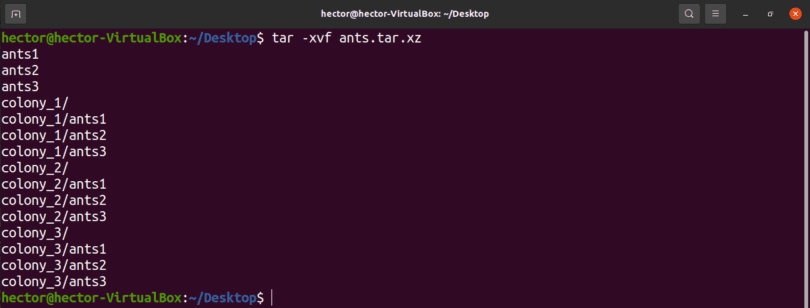
#Tar to untar in linux how to
Method 1: How to Untar a File from the Command Line
#Tar to untar in linux archive
Many people refer to them as tarballs, so if someone tells you that a file is packed up as a tarball then this is the type of archive they’re talking about. Technically tar stands for tape archive, which reflects its original usage for creating tape backups on big iron computers. Some users who are used to working purely from a command line might not know that they can also extract them graphically in most desktop environments. Even some experienced users don’t know the simple way to extract these from a command line. tar and may even have other extensions after it. Please do share share your feedback and queries in below comments section below.When you work with Linux, FreeBSD or other Unix implementations, you’ll often see files that end in. That’s all from this post, I hope you have found it informative. In case, there is an output then we can say that there might be some corruption in compressed tar backup. tar.bz2 $ tar -tvf system-back.tbz2 > /dev/nullĪbove commands should not produce any output on the screen. tar.gz $ gunzip -c system-back.tgz | tar -t > /dev/nullįor. To verify the integrity of compressed tar backup, use followingįor. In case of corruption, we will get the output something like below, If above command does not generate any output on the screen then we can say that there is no corruption. $ ls -l /var/tmp/ How to verify tar backup integrity?įor tar ball, use ‘-tf’ option and redirect the output to /dev/null file, $ tar -tf system-back.tar > /dev/null $ sudo tar -xpvf system-back.tgz -C /var/tmp/ In the following example we are extracting system-back.tgz in /var/tmp folder. In case you want extract it in a particular folder then use ‘-C’ option followed by the folder path. This command will extract system-back.tgz in the current working directory. Example is shown below $ sudo tar -xpvf system-back.tgz Use ‘-x’ option in tar command to extract tar backup, complete option would be ‘-xpvf’. Example is shown below: $ sudo tar -tvf system-back.tgz | grep -i etc/fstab To view the contents of tar backup, use ‘-t’ option, complete options would be ‘-tvf’. Run following command to exclude files mentioned in exclude.txt while creating tar backup of /etc $ sudo tar -X exclude.txt -zcpvf etc-backup.tgz /etc How to view the contents of tar backup? To use exclude feature we must create a exclude file which will have file name to be excluded. To exclude a file while creating tar backup, use ‘-X’ option followed by the exclude file. How to exclude file while creating tar backup? Note: We can not append files or folders to compressed tar backup as it is not supported. Let’s assume we want to append /root/app.yaml file to system-backup.tar, run $ sudo tar -rvf system-back.tar /root/app.yaml Let’s assume we want to take backup of /home/linuxtechi, /etc and /opt folder. To create a tar backup file, first identify the files and folders that would be part of your backup. In this post, we will demonstrate how to create backup with tar command in Linux. Once we have a tar backup ready then we can easily transfer it to remote backup server using scp or rsync commands.


This tar can also be compressed using gzip and bzip2 compression utility. Tar stands for ‘tape archive’ and can archive multiple files and directories into a tar file. Tar command can create backup of your application, configurations files and folders of the system.

#Tar to untar in linux for free
Hello Linux Geeks, if you are looking for free command line backup tools on Linux systems then tar command is the solution for you.


 0 kommentar(er)
0 kommentar(er)
